GST on Automobiles and Two-Wheelers – Price Impact 2025
Planning to purchase a new car or motorcycle in 2025? While you’re busy comparing models and features, one of the most significant factors affecting the final price is the Goods and Services Tax (GST). Understanding the GST impact on automobiles is crucial for making an informed decision, as this single tax determines a substantial portion of your vehicle’s on-road price. Before the GST regime, buyers had to navigate a complex web of taxes like Excise Duty, Value Added Tax (VAT), and various cesses, which made pricing opaque. GST simplified this by creating a unified tax structure, but it comes with its own system of rates and cesses that every prospective buyer must understand. This comprehensive guide will break down the GST impact on automobiles and two-wheelers in India. We will cover the current tax structure, explain how the final price is calculated, and look ahead at the potential 2025 car price GST impact for both individual buyers and small business owners. The Impact of GST on Small and Medium Enterprises extends beyond just vehicle purchases, affecting various operational aspects.
Understanding the GST Framework for Vehicles in India
To truly grasp how GST affects vehicle prices, it’s essential to understand its basic components. The tax you see on your final invoice isn’t just one flat rate; it’s a combination of different elements that vary based on your location and the type of vehicle you are purchasing. This framework was designed to streamline taxation across the country, ensuring uniformity while also addressing specific policy goals, such as compensating states for revenue loss and promoting certain industries like electric vehicles. A clear GST analysis on vehicles India reveals that the system comprises two main layers: the core GST rates and an additional levy known as Compensation Cess, which plays a pivotal role in the final pricing, especially for larger cars and SUVs.
The Core Components: CGST, SGST, and IGST
The Goods and Services Tax is broadly divided into three categories, and the one applicable to you depends on where the transaction takes place. While this might seem complicated, the end cost to you as a consumer remains the same.
- CGST (Central GST): This is the portion of the tax collected by the Central Government.
- SGST (State GST): This is the portion of the tax collected by the State Government where the sale occurs.
- IGST (Integrated GST): This tax is collected by the Central Government on inter-state transactions (when the buyer and seller are in different states).
Here’s a simple example: If you live in Mumbai and buy a car from a dealer in Mumbai (an intra-state transaction), the total GST will be split equally between CGST and SGST. For a car in the 28% GST slab, you would pay 14% CGST and 14% SGST. Conversely, if you reside in Bengaluru, Karnataka, and purchase a car from a dealer in Mumbai, Maharashtra (an inter-state transaction), the entire 28% tax will be levied as IGST. For the buyer, the total tax percentage is the same in both scenarios.
What is GST Compensation Cess on Automobiles?
On top of the standard GST rate, most cars and some high-end motorcycles attract an additional tax called the GST Compensation Cess. This cess was introduced with a specific purpose: to compensate state governments for any potential revenue loss they might incur due to the implementation of GST. Before GST, states had their own revenue streams from taxes like VAT, which were subsumed into the new system. The cess ensures that their revenues remain protected during the transition period.
For automobile buyers, this cess is a significant factor that inflates the final on-road price. It is not a flat rate; it varies widely depending on the vehicle’s category, determined by factors like its length, engine capacity (in cc), and fuel type. This cess is the primary reason why SUVs, luxury sedans, and high-performance vehicles face a much higher tax burden compared to small cars or electric vehicles, making it a critical component of the overall price effect of GST on automobiles.
Current GST Rates on Automobiles and Two-Wheelers
The total tax you pay on a new vehicle is a combination of the base GST rate and the applicable Compensation Cess. The government has created different slabs to categorize vehicles, leading to vastly different tax outcomes. This tiered structure directly influences manufacturing strategies and consumer choices, making it essential for buyers to know which slab their desired vehicle falls into.
GST Rate on Two-Wheelers
The GST on two-wheelers India has been a topic of much debate, as the industry has consistently argued that two-wheelers are a mode of essential transport for millions, not a luxury item. Currently, most motorcycles and scooters are placed in the highest GST slab.
- Two-Wheelers with engine capacity < 350cc: These are subject to a 28% GST with no additional cess. This covers the vast majority of commuter motorcycles and scooters in India.
- Two-Wheelers with engine capacity > 350cc: These vehicles attract a 28% GST plus an additional 3% Compensation Cess, bringing the total tax to 31%. This category includes performance and premium motorcycles.
This high tax bracket is a major contributor to the overall two-wheeler price GST impact India, affecting affordability for a large segment of the population.
GST Rate on Cars (Four-Wheelers)
For cars, the tax structure is more complex and is designed to tax smaller, more fuel-efficient cars at a lower rate than larger, more powerful ones. The government’s push for green mobility is also evident in the special rate for Electric Vehicles (EVs).
| Vehicle Category | GST Rate | Compensation Cess | Total Tax Incidence |
|---|---|---|---|
| Small Petrol Cars (< 4m length, < 1200cc engine) | 28% | 1% | 29% |
| Small Diesel Cars (< 4m length, < 1500cc engine) | 28% | 3% | 31% |
| Mid-size Cars / SUVs (> 4m length or >1500cc engine) | 28% | 17% – 22% | 45% – 50% |
| Electric Vehicles (EVs) | 5% | 0% | 5% |
Note: The dramatically lower 5% GST on Electric Vehicles is a deliberate policy decision by the government to incentivize their adoption and promote a cleaner environment. This makes EVs significantly more attractive from a tax perspective compared to their petrol or diesel counterparts.
Analyzing the GST Impact on Automobiles: A Practical Calculation
Understanding the percentages is one thing, but seeing how they translate into actual rupees and paise makes the impact much clearer. The Ex-Showroom price quoted by dealers is inclusive of GST and Cess. Let’s break down the automobile pricing changes due to GST with two practical examples.
Example 1: The On-Road Price of a Mid-Size SUV
Let’s assume you are buying a mid-size SUV with an engine capacity over 1500cc. This vehicle falls into one of the highest tax brackets.
- Hypothetical Ex-Showroom Price: ₹12,00,000
This price already includes a 28% GST and a 22% Compensation Cess (total tax of 50%). To find the original base price, we can do a reverse calculation:
- Total Tax Rate = 28% (GST) + 22% (Cess) = 50%
- Ex-Showroom Price = Base Price + (Base Price * 50%)
- ₹12,00,000 = Base Price * 1.50
- Base Price (pre-tax): ₹12,00,000 / 1.50 = ₹8,00,000
Calculation Breakdown:
- Base Price (pre-tax): ₹8,00,000
- Add: GST @ 28% on Base Price (₹8,00,000 * 0.28): ₹2,24,000
- Add: Compensation Cess @ 22% on Base Price (₹8,00,000 * 0.22): ₹1,76,000
- Total Ex-Showroom Price: ₹8,00,000 + ₹2,24,000 + ₹1,76,000 = ₹12,00,000
In this case, a staggering ₹4,00,000 of the vehicle’s ex-showroom price is just tax. Important costs like Registration, Road Tax, and Insurance are then calculated on top of this ₹12,00,000 figure, further increasing your final on-road price.
Example 2: The Price of a 200cc Motorcycle
Now, let’s look at a popular commuter motorcycle that falls under the 350cc category. This example highlights the direct GST implications for motorcycle buyers India.
- Hypothetical Ex-Showroom Price: ₹1,50,000
This motorcycle attracts a flat 28% GST with no cess.
- Ex-Showroom Price = Base Price + (Base Price * 28%)
- ₹1,50,000 = Base Price * 1.28
- Base Price (pre-tax): ₹1,50,000 / 1.28 = ₹1,17,187.50
Calculation Breakdown:
- Base Price (pre-tax): ₹1,17,187.50
- Add: GST @ 28% on Base Price (₹1,17,187.50 * 0.28): ₹32,812.50
- Total Ex-Showroom Price: ₹1,17,187.50 + ₹32,812.50 = ₹1,50,000
Here, the total tax component is nearly ₹33,000, which is a significant portion of the price for a vehicle often purchased by middle-class and lower-middle-class individuals.
The 2025 Car Price GST Impact and What It Means for Businesses
As we look towards 2025, prospective buyers and business owners are keenly watching for any potential changes in the GST structure for automobiles. The automotive industry is a major contributor to India’s GDP, and tax policies play a huge role in its health and growth. For businesses, understanding these nuances is not just about the purchase price but also about tax liabilities and credits.
Are Any GST Rate Changes Expected in 2025?
While there has been no official announcement from the government, there is persistent market sentiment and industry lobbying for GST rate rationalization. The automotive sector, particularly the two-wheeler segment, has been advocating for a reduction in the GST rate for years. Their argument is that a lower tax rate (e.g., moving from 28% to 18%) would make vehicles more affordable, boost demand, and ultimately lead to higher overall tax collection due to increased sales volume.
Similarly, there are discussions about restructuring the Compensation Cess on cars to be more uniform or based on factors other than just engine size and length. However, buyers in 2025 should base their financial planning on the current tax structure, as any changes are speculative until officially notified by the GST Council.
For Business Owners: Claiming Input Tax Credit (ITC) on Vehicles
This is a critical area for small business owners. Input Tax Credit (ITC) allows a business to claim back the GST paid on purchases (inputs) used for running the business. However, the rules for vehicles are very specific and often misunderstood, making it crucial to understand the ITC on Motor Vehicles: Understanding the Eligibility Criteria.
In general, businesses cannot claim ITC on the purchase of motor vehicles with a seating capacity of up to 13 persons (including the driver). This means if you buy a car for your director or for employee transportation, you cannot claim the GST paid on it as a credit.
However, there are specific exceptions where ITC is available:
- Further Supply: If your business is in the business of selling vehicles (e.g., a car dealership), you can claim ITC on the cars you purchase to sell.
- Passenger Transport: If the vehicle is used for providing passenger transportation services (e.g., a taxi service, cab aggregator, or a tour operator), ITC can be claimed.
- Driving Training: Businesses that use vehicles for imparting driving training can claim ITC.
- Goods Transportation: ITC is fully available on commercial vehicles designed for the transportation of goods (e.g., trucks, loaders).
Understanding these rules is crucial to ensure GST compliance and optimize your tax liability. Misinterpreting ITC rules can lead to penalties. For expert guidance on managing your business’s GST obligations, consider exploring TaxRobo’s “GST Filing Services” page.
Conclusion
The final price of any new car or two-wheeler in India is significantly determined by its designated GST and Compensation Cess slab. For prospective buyers, this means that a vehicle’s engine size and length can have as much of a financial impact as its brand and features. The current tax structure heavily favors Electric Vehicles, offering a huge tax advantage that is likely to influence purchasing decisions more and more in the coming years. Ultimately, a clear understanding of the GST impact on automobiles helps you budget accurately for your next purchase and avoid any last-minute surprises at the showroom.
Whether you are a salaried individual carefully planning for your dream car or a business owner looking to expand your fleet, being aware of the complex tax implications is the first and most important step toward making a smart, financially sound decision. The rules, especially around Input Tax Credit for businesses, require careful navigation.
Navigating GST for business vehicle purchases can be complex. If you need expert advice on ITC claims or GST compliance, schedule a consultation with the TaxRobo experts today!
Frequently Asked Questions (FAQs)
Q1: Can I claim GST input credit on a car purchased for my company director?
A: No, Input Tax Credit (ITC) is generally blocked for motor vehicles with a seating capacity of less than 13 persons, even if purchased in the company’s name for a director. This falls under the category of Blocked Credits Under Section 17(5): What ITC Cannot Be Claimed?. The exceptions are for businesses involved in transport, training, or vehicle sales.
Q2: What is the GST rate on second-hand or used cars?
A: The GST on used cars is lower. It is levied on the margin (difference between the selling and purchase price) of the dealer. The rates are typically 12% for small cars and 18% for larger cars, applicable only to the dealer’s profit margin, not the entire vehicle value.
Q3: Does the GST rate change if I buy a car with a bank loan?
A: No, the GST rate on the vehicle itself does not change. However, financial services like loan processing fees and other charges levied by the bank will have their own GST component, which is typically 18%.
Q4: Is GST also applicable on vehicle insurance and servicing?
A: Yes. Car insurance premiums attract GST at a rate of 18%. Similarly, vehicle servicing, which includes both labour charges and the cost of spare parts, also attracts GST. The rate is generally 18% on services and can be up to 28% on certain auto parts.
For the most current and official rates, readers are advised to refer to the CBIC (Central Board of Indirect Taxes and Customs) website.



